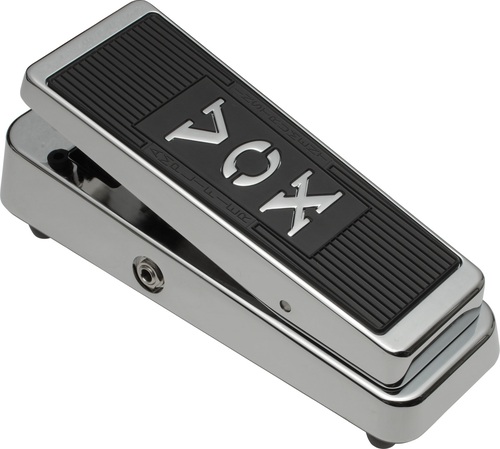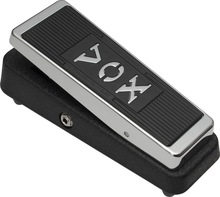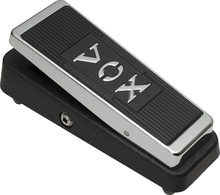
VOX VRM-1 Real McCoy LTD - Limited Wah Pedal
Limited Edition Wah-Wah!
Real McCoy WahWah Pedal - Limited Chrome Edition
From the original creators: The Epitome of Wah Pedal Replication
Introduced by VOX in 1967, the Wah-Wah pedal was initially conceived to emulate Clyde McCoy's trumpet mute technique. However, an unintended but music-changing use with electric guitar turned the Wah pedal into a vital tool for renowned artists such as Jimi Hendrix and Eric Clapton, driving the creation of now-legendary performances and compositions. From the 1960s, ‘70s and ‘80s. To this day, the Wah-Wah pedal has become an essential tool for discerning guitarists.
Wah pedals from the early days are now classified as vintage: not only rare but also sought after due to their distinctive tone. However, high costs and component reliability make them risky to use on stage. They can also be expensive to maintain due to the cost of replacement parts.
As a result, VOX engineers have worked hard to unravel the mysteries of the original wah. After years of research and multiple prototypes, VOX is proud to offer a line of new Wah pedals designed to meticulously replicate the exact tonal characteristics of the ultimate pedals associated with the McCoy Wah and V846.
There are two new Wah pedals, designed to cater to diverse musical applications: the VRM-1 and V846 Vintage, alongside the opulent Limited Edition VRM-1 completely encased in chrome plating.
The Pursuit of the Ultimate Vintage Wah
Vintage wahs are renowned for their distinctive sound profiles, with each unit exhibiting unique characteristics owing to the inherent simplicity of their circuitry and the markedly individualized nature of their components. Two wahs emanating from the same production line and produced at the same time may sound quite different!
We started our journey by acquiring a mint condition vintage 1960s Wah, referred to at VOX as the "Holy Grail" - the epitome of the ideal unit.
Unlocking the Mystery Behind the Iconic Frequency Curve
Once we had our “holy grail” wah, we conducted exhaustive A/B testing, systematically comparing its frequency response against that of other more conventional vintage units. This extensive exploration unraveled the alchemy inherent in vintage components that collectively shape the unique frequency curve characteristic of the holy grail unit.
Let’s delve further into the intricacies of this journey.
Inductors: The Crucial Component in Wah Technology
The "Halo" inductor stands as the quintessential element in the vintage wah. By meticulously analyzing the inductor characteristics of vintage units, we have successfully replicated the Halo inductor to incorporate it into our wahs.
Subtle modifications to the inductors of the VRM-1 and the V846 Vintage have been implemented, yielding distinct tonal characteristics.
The VRM-1, renowned for its iconic nasal tone, accentuates the midrange, imparting a warm and melodic quality for expressive lead guitar playing that underscores the articulation of each note.
Conversely, V846 Vintage presents a more assertive tonal profile, characterized by an extended sweep range and heightened emphasis on high frequencies. It stands as the definitive rendition of the widely recognized wah-wah effect.
As always, vintage wah-wahs exhibit inherent variations owing to tolerances in vintage components. By meticulously refining the core material, the pivotal element of the inductor, we achieved the ideal balance of tone characteristics.
Potentiometer: An Integral Component in Wah Dynamics
The potentiometer, a variable resistor, is the pivotal element driving the wah sweep. When the potentiometer from the vintage unit was copied, meticulous adjustments were made to ensure a near-identical curve. The VRM-1 and V846 Vintage models employ distinct resistance values and curves
Transistor: Precision in Component Matching
Employing the appropriate transistor, specifically the BC108 model with identical numbering and appearance as its vintage counterpart, delivered precise component matching. This configuration requires careful assembly due to the interaction with the bottom plate, an integral component of the transistor's terminals. Despite the availability of similar transistors, the tonal variance observed when compared to 60s components required a custom circuit for tone adjustment. Even though additional components not present in the original unit have been introduced, our new Vox wah pedals authentically recapture the essence of a bygone era.
Resistor: Navigating the Evolution of Resistive Elements
In guitar amplifiers, "carbon composite" resistors were once highly regarded. However, by the late ‘60s, "carbon film" resistors, cost-effective and consistent in quality, became standard. The VOX Wah, introduced in 1968, also adopted carbon film resistors. However, in the new VOX wah pedals, larger 1/2W carbon film resistors are utilized to faithfully replicate the vintage Wah tonal characteristics. By moving away from chip resistors and 1/4W resistors, we can deliver an even more authentic sound.
Capacitor Influence on Tone
In a Wah circuit, 0.01uF capacitors can impact the tonal quality. Vintage wahs employed capacitors of unique shapes unsuitable for contemporary production, and so metallized polyester capacitors have been used. The capacitor with the most profound tonal resonance was meticulously selected after analyzing many different options.
Casing: Influential Factors in Wah Effect Pedal Construction
The design of the case plays a pivotal role in the Wah effect pedal, impacting both the angle at which the foot engages and the pedal's range of motion.
Achieving expressive control of the Wah necessitates subtle foot manipulation of the pedal. Consequently, even with the replacement of all electronic components from Vintage, alterations in the case design elicit a perceptible "difference" in pedal feel. To address this, a new mold was created by disassembling the vintage unit and conducting a 3D scan of both the lower case and the pedal. Ensuring that the pedal moves at the same angle as the vintage counterpart, in conjunction with the potentiometer, enables the faithful reproduction of the vintage wah.
The Wah, being a high-impedance circuit with a current consumption of less than 1mA, is particularly susceptible to environmental influences compared to other effect pedals and so aluminum is used. However, during prototyping, a slight roll-off in the high-frequency range was detected due to material composition discrepancies compared with the vintage pedals and so modifications were made to the grounding to mitigate the attenuation of high-frequency components generated by the jack. The addition of a washer effectively insulated the ground section of the case and the jack.
The bottom plate, not just the case, holds significance among some vintage enthusiasts, who assert that the material of the bottom plate influences the sound of the Wah. Thus, replicating the vintage sound necessitated reproducing the tonal characteristics associated with the bottom plate. Processing an iron plate, known for inducing substantial tonal changes, completes the drive for total authenticity.
Wire Materials: Tonal Impacts in High-Impedance Circuits
Similar to how a guitar cable influences tone, the choice of wire material in a high-impedance circuit like wah is consequential. Thinner wire generally produces a narrower sound with limited tonal range, while thicker wire tends to generate a broader spectrum extending into higher frequencies. Strand wire, typically utilized for such circuits, exhibits these tendencies based on wire thickness and strand count. The wire materials typically used, such as AWG24 with 11 cores and a strand size of 0.16mm, and AWG26 with 7 cores and a strand size of 0.16mm, are augmented in the new VOX Wah pedals to AWG24 with 7 cores and a strand size of 0.2mm. By using thicker wires while retaining the 7-wire braid, we were able to strike a perfect balance of keeping the tone bright yet not to the point of becoming overpowering.
The VRM-1 and V846 Vintage stand as the culmination of the passion of the VOX engineers' to bring back the authentic vintage VOX wah sound for today’s guitarist.
Main Specifications:
- Connections: INPUT jack (monaural phone jack), OUTPUT jack (monaural phone jack)
- Power supply: 9V dry cell batteries (6LF22/6LR61) (sold separately)
- Battery life: approx. 100 hours or more (with alkaline batteries)
- Current consumption: 540µA (9V DC)
- Dimensions (W x D x H): 102 x 252 x 80 mm
- Weight: 1300 g (excluding batteries)
- Accessories: Carrying bag, instruction manual








